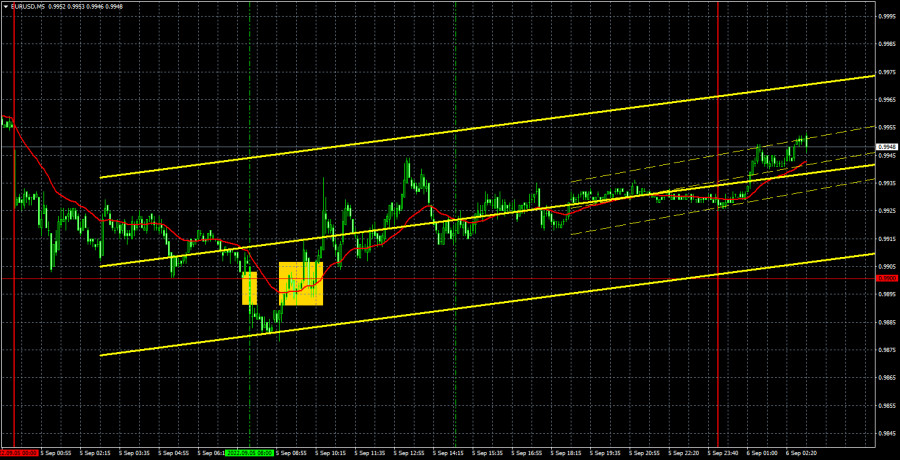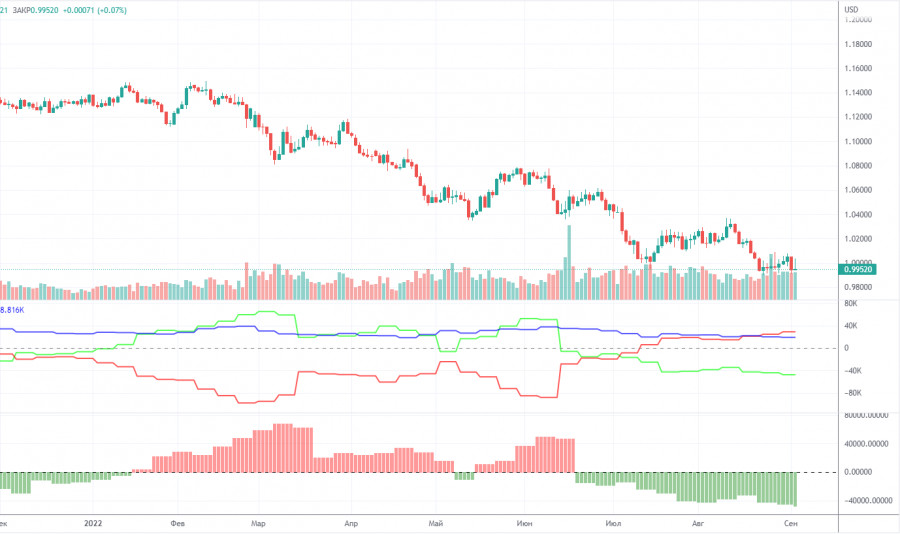

The EUR/USD pair did not trade in the best way on Monday. It has not been such for a long time that during the day there is a blatant flat with low volatility. Sooner or later it had to happen. There were no important macroeconomic statistics either in the European Union or in the US on Monday. Two reports were published in Europe, but the first is the index of business activity in the service sector in the second assessment for August - that is, a priori, not the most interesting report for traders, and the second - retail sales, the value of which for July almost coincided with the forecast. It was naive to expect a market reaction under such circumstances. It didn't happen. The euro managed to retreat literally 50 points from its 20-year lows, so we believe that the pair's fall will resume again. Moreover, the European Central Bank meeting will take place this week, and the market reaction to its results can be absolutely anything, despite the fact that it is already known that the key rate will be increased by at least 0.5%. But once again: the reaction of the market can be completely unpredictable. Therefore, it is not at all a fact that this week we will see a strong growth of the euro.
In regards to Monday's trading signals, everything was also very sad. Only two of them were formed. The first one to sell is definitely false, since the price could not go in the right direction by even 15 points. The second one is a little better, one could earn about 15-20 points for the long position and cover the loss on the first transaction. The result is absolutely normal for Monday.
COT report:
The Commitment of Traders (COT) reports on the euro in the last few months clearly reflect what is happening in the euro/dollar pair. For most of 2022, they showed an openly bullish mood of commercial players, but at the same time, the euro fell steadily at the same time. At this time, the situation is different, but it is NOT in favor of the euro. If earlier the mood was bullish, and the euro was falling, now the mood is bearish and... the euro is also falling. Therefore, for the time being, we do not see any grounds for the euro's growth, because the vast majority of factors remain against it. During the reporting week, the number of long positions for the non-commercial group decreased by 8,500, and the number of shorts decreased by 5,000. Accordingly, the net position decreased by about 3,500 contracts. This is not much, but this is again an increase in the bearish mood among the major players. After several weeks of weak growth, the decline in this indicator resumed. From our point of view, this fact very eloquently indicates that at this time even commercial traders still do not believe in the euro. The number of longs is lower than the number of shorts for non-commercial traders by 47,000. Therefore, we can state that not only does the demand for the US dollar remain high, but that the demand for the euro is also quite low. The fact that major players are in no hurry to buy the euro may lead to a new, even greater fall. The euro has not been able to show even a tangible correction over the past six months or a year, not to mention something more.
We recommend to familiarize yourself with:Overview of the EUR/USD pair. September 6. The ECB meeting is the key event of the week.
Overview of the GBP/USD pair. September 6. An almost empty week for the pound. What can stop it from falling against the dollar?
Forecast and trading signals for GBP/USD on September 6. Detailed analysis of the movement of the pair and trading transactions.
EUR/USD 1HThe pair continues to be inside the 0.9900-1.0072 channel on the hourly timeframe, although it briefly left it during the past day. The lower limit of this channel has been broken, and we have no doubt that the euro will continue to fall. But this week it is quite possible that the "broad flat" will continue. We highlight the following levels for trading on Tuesday - 0.9900, 1.0019, 1.0072, 1.0124, 1.0195, 1.0269, as well as Senkou Span B (0.9996) and Kijun-sen (0 .9978). There is still no level below 0.9900, so there is simply nothing to trade there. Ichimoku indicator lines can move during the day, which should be taken into account when determining trading signals. There are also secondary support and resistance levels, but no signals are formed near them. Signals can be "rebounds" and "breakthroughs" extreme levels and lines. Do not forget about placing a Stop Loss order at breakeven if the price has gone in the right direction for 15 points. This will protect you against possible losses if the signal turns out to be false. No important events are planned in the European Union on September 6, meanwhile, the indexes of business activity in the services sector ISM and S&P will be published in the US. The first is more important and may follow the second - that is, below the 50.0 level. We are waiting for the market's reaction to this report, especially since it is almost the only one this week.
Explanations for the chart:Support and Resistance Levels are the levels that serve as targets when buying or selling the pair. You can place Take Profit near these levels.
Kijun-sen and Senkou Span B lines are lines of the Ichimoku indicator transferred to the hourly timeframe from the 4-hour one.
Support and resistance areas are areas from which the price has repeatedly rebounded off.
Yellow lines are trend lines, trend channels and any other technical patterns.
Indicator 1 on the COT charts is the size of the net position of each category of traders.
Indicator 2 on the COT charts is the size of the net position for the non-commercial group.